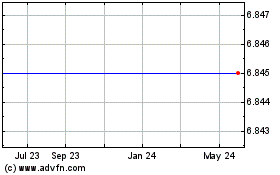UPDATE: SanDisk To Acquire Pliant Tech For About $327 Million
May 16 2011 - 12:52PM
Dow Jones News
SanDisk Corp. (SNDK) agreed to acquire solid-state drive company
Pliant Technology Inc. for about $327 million plus incentives,
giving the flash-memory maker a foothold in the enterprise storage
market.
SanDisk, once mainly known for small storage cards and thumb
drives sold in retail stores, has benefited from selling flash
memory chips for devices like smartphones, tablets and digital
music players. The company, through its acquisition of Pliant, is
now targeting solid-state drives, or SSDs, used by businesses in
data centers, a market Gartner expects to soar to $4.2 billion in
2015 from $994 million in 2010.
"It's a really profitable market," Sumit Sadana, SanDisk senior
vice resident and chief strategy officer, said in an interview. "We
[thought we] could bring lot of the benefits of SanDisk's
capabilities and marry them with the really great technology Pliant
has introduced to customers and is the middle of ramping."
SanDisk shares, up 18% over the past 12 months, climbed 5.8% to
$49.18 in recent trading.
Demand for SSDs has been growing as companies generate and save
more data. The devices allow businesses to access their information
much quicker while consuming less power than hard-disk drives, but
they also typically are more expensive on the outset.
Pliant currently sells high-end SSDs to storage giants like EMC
Corp. (EMC), competing against companies like STEC Inc. (STEC). The
type of technology Pliant uses--known as multi-level cell, or MLC,
NAND flash--makes the devices more cost efficient. That should
accelerate adoption of SSDs in data centers and help SanDisk expand
in the market, Gartner analyst Joseph Unsworth said.
"If you want to drive adoption of SSDs...the way to do that is
going to cheaper flash but not compromising on quality," Unsworth
said. "Pliant has one of the best solutions in the industry."
But even with its strong technology, SanDisk faces fierce
competition in the enterprise storage market. Hard-disk drive
makers such as Seagate Technology Inc. (STX) have targeted the
area, as have companies like memory maker Micron Technology Inc.
(MU). Most of the companies already have relationships with the
storage makers, something that puts them at an advantage.
"While Pliant has a good solution, SanDisk is going to have to
step up to provide more of that support and services so they can
battle with these guys who have been doing this for an awful long
time," Unsworth said.
No Pliant offerings currently use SanDisk flash, but the two
companies have been working to qualify SanDisk's memory in Pliant's
products. The process typically takes nine to 12 months, and Sadana
said the first products using technology from Pliant and SanDisk
should be introduced in the first half of 2012.
SanDisk expects the deal, projected to close in the current
quarter, to cut 2011 adjusted earnings by 2% to 3% and add to
profit, excluding items, starting next year.
SanDisk last month reported its first-quarter profit fell 4.5%,
though revenue growth topped expectations and executives said they
expected demand would remain strong despite supply constraints in
Japan.
"As they build their presence in the enterprise server and
storage market, there's more consistency, better profits and a
different level of [original equipment manufacturer] relationships
than they've had before," Wedbush analyst Betsy Van Hees said.
"It's an area they've definitely been lacking."
-By Shara Tibken, Dow Jones Newswires; 212-416-2189;
shara.tibken@dowjones.com
(Tess Stynes contributed to this report.)
Simpletech (NASDAQ:STEC)
Historical Stock Chart
From Jun 2024 to Jul 2024

Simpletech (NASDAQ:STEC)
Historical Stock Chart
From Jul 2023 to Jul 2024
